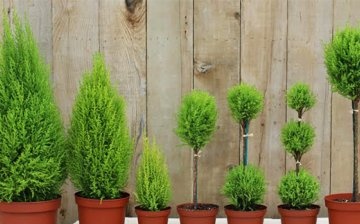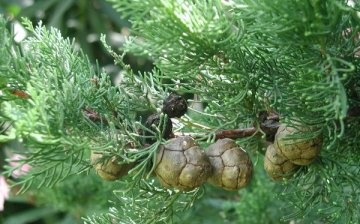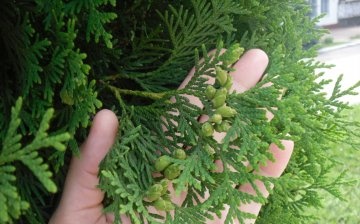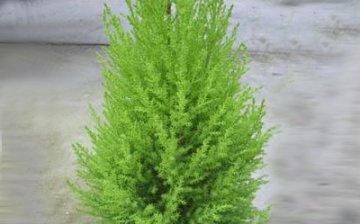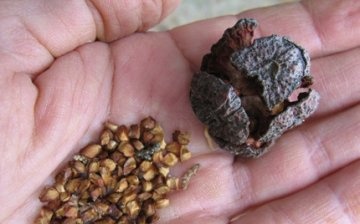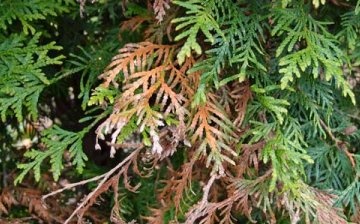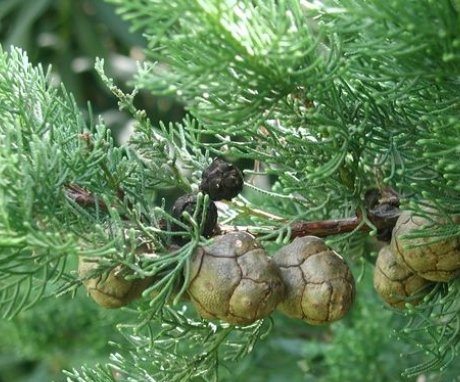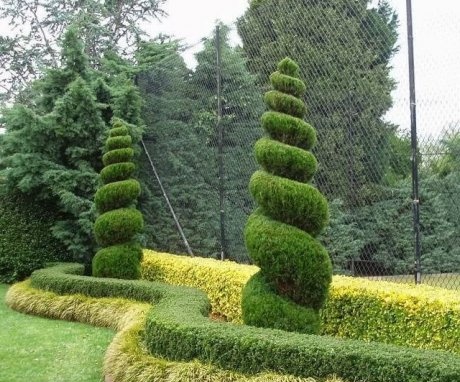Gardener's cheat sheet: how to properly care for a cypress
Cypress has become a decoration of gardens, greenhouses and parks since ancient times. Its spectacular, spreading crown and impressive size fascinate passers-by. Thick, luscious greenery is pleasing to the eye all year round. Every gardener and just a lover of coniferous crops dreams of having an evergreen, luxurious tree. It is given creative forms and is used as vertical landscaping in gardens.
In landscape design, cypress is widely used to decorate large parks and gardens. Thanks to breeders, it became possible to breed it in rather harsh conditions. This is what plant breeders use. The tree is successfully grown in the open field and at home. The gardener will learn how to care for cypress from this useful guide.
Content
- Evergreen handsome - description of the cypress
- Types and varieties of cypress
- Growing conditions: lighting and temperature
- Proper plant care: watering, feeding and transplanting
- Cypress propagation
- Diseases and pests of cypress
Evergreen handsome - description of the cypress
It is an evergreen plant that belongs to the cypress family. In nature, it occurs in the form of a tall, stately tree or shrub. The latter is a rather rare phenomenon. The habitat of the plant is North America, the Mediterranean, the Himalayas, the islands of Crete and Cyprus, as well as the south of China. In Russia, the plant is grown in the south of Crimea. Thanks to the development of frost-resistant varieties, cypress is also cultivated in the central zone of the country.
Many conifer lovers grow a handsome man at home.
Description of cypress:
- The plant is a slow growing tree. Reaches 70 m in height in places of wild growth.
- The crown is pyramidal or spreading, depending on the species.
- The leaves are like needles, fitting tightly to the branches. With age, they change their shape and become covered with scales.
- The fruits of the tree, cones, are round, sometimes cylindrical. A very beautiful, intricate pattern is formed on the fruits. Cones densely cover the "paws" of the ephedra.
- Both male and female fruits grow on the same tree, which is a distinguishing feature of cypress from other types of conifers.
- Cypress is fully ripe after about 100 years.
Cypress is considered one of the most ancient plant species, as its bark and needles were found in fossils. Their age belonged to the Cenozoic era. In Christianity, cypress is credited with healing properties; it is considered a symbol of longevity and good health. Wood was used to build houses, ships and other structures. It is naturally resistant to moisture and temperature extremes.
Cypress disinfects the air, has a positive effect on the central nervous system and is a natural antiseptic. A plant in a room or garden will be a great natural air purifier, especially if you have a household with respiratory problems. Cypress will become not only a decorative element of a garden or a room, but also a "home doctor". Its breeding is shown both in the garden and at home.
Types and varieties of cypress
The coniferous plant has about 25 species. However, for the purpose of decorative landscaping, only a few are used, less than 10. Almost all of them are intended for warm countries with high air humidity. Cypress loves sun and moisture.
The following types of plants are distinguished:
- "McNaba" - this species has a pyramidal shape. It grows up to 12 m. The cypress is suitable for growing in harsh conditions. Frost-resistant, unpretentious.
- Common cypress - reaches a height of up to 30 m. The foliage is gray, the cones are large, the shape of the crown is pyramidal. Prefers to grow in warm climates - Mediterranean. Not suitable for cultivation in Russia, does not tolerate frost.
- "Mexican" - a kind of tree common in warm regions - Mexico, the south of the United States. Reaches a height of 45 m. Has a pyramidal shape, medium-sized cones, dark brown. The species is not suitable for cultivation in Russia, not frost-hardy.
- Cypress "Arizona" is subdivided into varieties depending on the shape of the crown, the color of the foliage. Not only trees are distinguished, but also shrubs that can be grown at home. Of the many species, only two are suitable for central Russia - "Arizona" and "McNaba". But they also require special growing conditions.
Growing conditions: lighting and temperature
Cypress loves a warm and humid environment. The main condition for growing a tree is bright, but diffused sunlight. If you plan to plant a seedling in the garden, it is necessary to choose a southern site so that the light is diffused and does not fall on the tops of the young tree. A little shading is appreciated. Cypress grows well in fertile and well-drained soils. It is advisable to grow the plant in areas protected from the wind. In the lowlands, where the soil is constantly damp, it is better not to plant a tree.
It does not tolerate dampness, root rot may appear.
The optimal substrate for cypress will be a mixture of turf and leaf land, peat and sand. The ratio is 1: 2: 1: 1. Small trees or shrubs are grown at home. They also require good lighting - diffused sunlight. It is necessary to maintain air humidity in the room - above normal. If the air in the room is too dry, the cypress will die.
The temperature of the content in the summer is 20 ° -25 °, in the winter - 10 ° -15 °. It is imperative to maintain these indicators, otherwise the tree will begin to shed needles, turn yellow. The prerequisites for growing are not so much the composition of the soil, but the humidity and temperature. Failure to comply with the indicators will lead to the death of the cypress.
Proper plant care: watering, feeding and transplanting
In the summer, in the phase of active growth, the plant is watered abundantly. On hot days, the sprinkling procedure is carried out - this is a necessary measure to prevent the young tree from withering.
If the cypress tree grows in the room, the procedure spraying should be carried out as often as possible, since the air in the room is very dry. Watering the cypress is desirable with rainwater or tap water, but warm and settled. Make sure that the earthy ball is evenly moistened. Dryness or dampness is unacceptable, the soil should be moderately moist.
In winter watering cypress is significantly reduced - up to once a week or two, depending on temperature conditions.
The higher the air temperature, more than 15 °, the more often the plant needs to be watered. However, cypress is less hydrated in winter. In open ground conditions, the tree is completely covered for the winter in the first four years of growth. It is covered with bark, sawdust, covered with non-woven fabric and closed with a wooden box. Before closing the cypress for the winter, the tree is watered abundantly.
Top dressing:
- In the first 4 years of the life of a cypress, both in the open field and at home, complex fertilizers from May to September. Frequency - once every three weeks. These are the most active years when the tree is forming and growing intensively.
- You can feed it with a mixture of 10 liters of water, 10 g of superphosphate and 2 kg of manure.
- An adult plant is fertilized only twice - in spring and autumn.
- Be sure to moisten the soil before applying any fertilizer.
Top dressing cypress plays an important role, especially if the tree is grown in harsh conditions. He needs to be helped to gain strength in the early years. Further, the cypress will enter a phase of slow growth and will develop for many decades.
In the conditions of rooms, cypress is transplanted once every two years. The plant does not like this procedure, as it prefers rest, it is better not to touch or move it. Transplant carried out by the method of transshipment of the old earthen coma into a new flowerpot. Only the top soil layer is updated. Cypress does not tolerate damage well root system... Therefore, the transplant is carried out very carefully. The procedure is carried out in the spring - from April to May. If the plant is planned to be planted in open ground, it is advisable to do this in June. Timely transplanting contributes to the good development of the plant. However, the procedure must be carried out very carefully.
Cypress propagation
The plant is bred with seed or cuttings. The first method is not very popular, since you need to grow an adult tree first. Purchased seeds are often unmatched. Cuttings on the contrary, it has gained wide popularity in the cultivation of cypress. The shoots germinate easily, there are no problems with them.
To obtain a cutting, it is necessary to cut off the upper shoots of the cypress.
The stalk should be with a heel. The plant is placed in a light substrate of peat, leaf and sod land. Cover with foil for better germination. This is the simplest method. If there are cypress seeds, they are planted in spring in a light substrate under a film. As the seedlings grow, the plant is transplanted into a flowerpot, then into open ground - in the second or third year of life.
Both seeds and cuttings are good for breeding a handsome coniferous man. For faster results, growers prefer the cuttings method.
Diseases and pests of cypress
The most common problem in growing cypress is his crown. At the slightest temperature drops, the foliage turns yellow, the needles begin to fall off. Dry air and insufficient watering... For the same reason, spider mites and scale insects may appear. The first one is quite simple to detect, the tick and its cobweb can be seen on the leaves and between them. A sign of the appearance of a scale insect is brown spots on the needles, stems. To fight with pests it is necessary with the help of insecticides - "Actellik", "Karbofos".
But, perhaps, the most dangerous disease for cypress is root rot.
It appears due to waterlogging of the soil. In this case, only transfer... But if the roots are badly damaged, the cypress is thrown away. Observing the rules of caring for the plant, you can prevent the appearance of pests and diseases of the cypress.
Care for a slender and stately cypress, it is difficult in that you need to constantly monitor the air temperature and humidity. However, having provided him with the proper conditions, he will delight the owners with a luxurious crown, healing properties and decorative appearance.
More information can be found in the video.



